Work to improve the resilience of the railway infrastructure to climate change is once again in full swing at Dawlish, on the coastal stretch of the Great Western Main Line between Exeter and Newton Abbot.
Following the major breach of the sea wall in February 2014 – necessitating a full line closure for eight weeks whilst major emergency restorative works were carried out – the location has not often been out of the news. After a detailed study by Network Rail to develop a ‘climate resilience’ strategy for the next 100 years, some of the major physical works necessary to fulfil that strategy are now in full progress.
A staged approach
Phil Morton, Project Manager for Network Rail showed Rail Engineer the works and explained the overall programme. The first stage (Stage 1) ran from May 2019 to July 2020 and saw the construction of 360 metres of new sea wall in front of the original structure supporting and protecting the railway alongside Marine Parade.

The second stage, actually split into two distinctly different parts (Stage 2a and Stage 2b), is now on site. Stage 2a comprises the construction of a 315-metre length of new sea wall alongside Dawlish Station and from Coastguards breakwater through to Dawlish Water, the local river’s outfall to the beach.
Stage 2b will see the completion of the sea wall between Stage 1 and Stage 2a, including bridging over Dawlish Water. It also comprises the reconstruction of the Down platform and the provision of passenger lifts and a new footbridge.
Design considerations
The stretch of sea wall being built in Stage 2a has a superficially similar external appearance and design to that of the wall in Stage 1. However, the internal and foundation arrangements are necessarily different because of the greater depth to solid rock over the extent of the Stage 2a wall.
Evaluation of the condition of the original Brunel masonry wall, with the knowledge of its frequent susceptibility to marine damage and the difficulty in achieving adequate repairs, meant that it was decided to go for the most robust alternative: that is to build a completely new and independent wall in front of the old one. The form that this wall takes is a row of circular hollow section (CHS) piles twisted into the rock, rather than driven, to reduce the impact on the local receptors and achieve the required imbedment. This is followed with a scour-protective concrete footing, then faced with precast reinforced concrete units, capped with recurve units and the void between the old and new wall completely backfilled with low-carbon mass concrete which was developed and designed by BAM Nuttall and Hanson.
The wall had to be approved for planning and environmental considerations by the local authority, Teignbridge District Council, and the Marine Management Organisation. Various options for the height of the wall and profile of the recurve capping were modelled in the laboratory at HR Wallingford to verify the computer-based modelling and ensure that the correct solution is being implemented to give 100 years resilience.
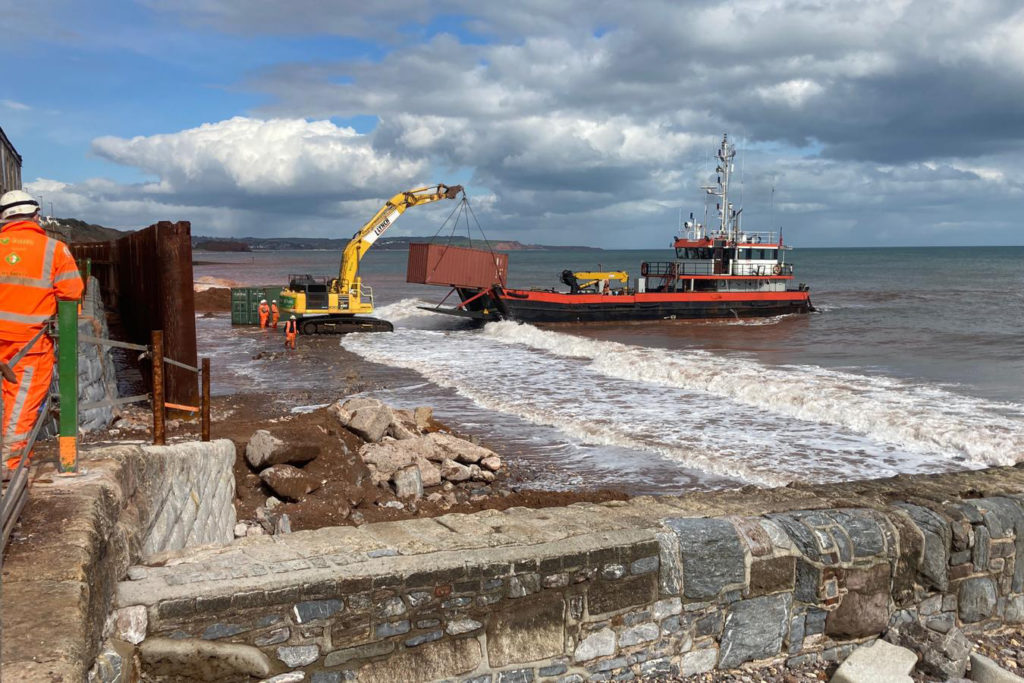
The existing sea wall is heavily used by the local community and also forms part of the South West Coast Path. It is a very popular local amenity to walk on – as is the beach below it – and there were always going to be some objections to the original masonry wall being no longer visible. However, the new wall will provide a much wider and safer walkway at a higher level. As a measure to reduce the visual impact of the concrete wall, Reckli Yukon formliner has been used to provide the facing panels with a textured finish.
Consultants for the overall design of Stage 2a are Arup for the development and Tony Gee and Partners for the detailed design. The main contractor – also responsible for Stage 1 – is BAM Nuttall, awarded a design and build contract.
Construction environment and sequence
Obviously, virtually all the preparation and construction aspects of the new wall are subject to tidal working. The only available time for placing scour protection, casting of the recess to receive the wall units, installation of the wall units and infill grouting is between 4 and 6 hours, depending on the tidal range changes between Spring and Neap tides. Longer working times were possible for the pile installation thanks to the use of a WaveWalker. BAM Nuttall has opted to work both low tides in each 24-hour period, whatever their times.
The CHS piles were installed between November 2020 and February 2021 using the WaveWalker jack-up barge, supplied by Fugro and Van Oord in a joint venture. It is believed that, for maintenance on Britain’s railway infrastructure, this was the first use of this impressive piece of equipment, an eight-legged platform capable of vertical height adjustment, lifting and handling piles into position very accurately for installation and which is able to literally ‘walk’ itself to its next operating position.
The WaveWalker was specifically modified to allow for its intended use by welding a large cantilever bracket onto the outside of the barge to support the 114-tonne piling rig during the installation of the piles. The opportunity was taken, before releasing the WaveWalker from site, to also install some of the piles needed for the Stage 2b part of the scheme.
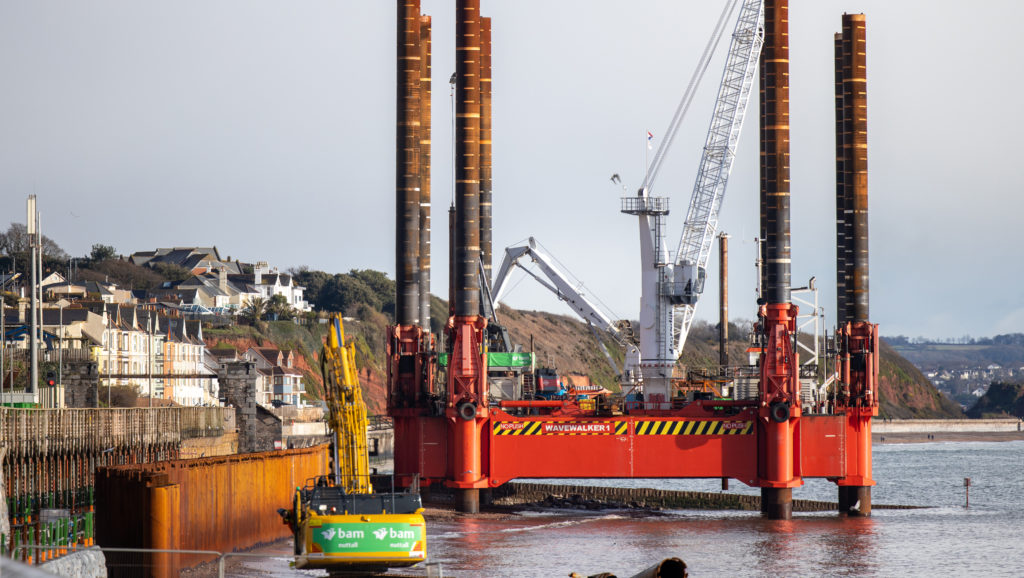
The piles are 762mm in external diameter and vary from 13-16 metres in length. Once in place, they are filled with mass concrete and, on the seaward side, are protected from future scour damage by a 1.5-1.8-metre deep mass concrete bench. The casting of this concrete scour protection requires repeated re-excavation of the beach material between tides to progress the installation.
A suitable concrete mix was developed for this particular operation by Hanson and BAM Nuttall by trialling six different mix designs on Stage 1 of the project, of which only one was suitable for the intended use/design life of the substructure. The mix contained a large variety of additives including microsilica, UCSPak and VC20RM which were required to allow BAM Nuttall to place the concrete in a marine/tidal environment.
Following progressive completion of the scour protection, a further structural element is added, again requiring repeated re-exposure between tides until completion. This final stage is the shuttering and casting of a concrete trough to retain the bottom of the precast facing wall units.
Manufactured in Ireland by Shay Murtagh, these are 2.0 metres in width and up to 6.5 metres in height, weighing just under 14 tonnes. Fixing of the wall units and the precise adjustment of their position is an ingenious process, developed by BAM Nuttall and Tony Gee using experience gained during Stage 1.
Each adjacent pair of CHS piles has short channel sections welded horizontally onto the rear side of the exposed portion of the piles – at the midpoint and lower down – to form two walings. Threaded tie bars cast into the wall unit are then used to pull itself in against the walings to adjust its position. At the top of each unit, there are two other cast-in articulated ties. These are laid on an adjustment grillage which is bolted to the top surface of the concrete infill to each of the two piles. This facility enables adjustment of the upper end of the wall unit. So, between the two tie bars and the upper wall ties, the final correct geometry of the wall unit is relatively easily achieved.
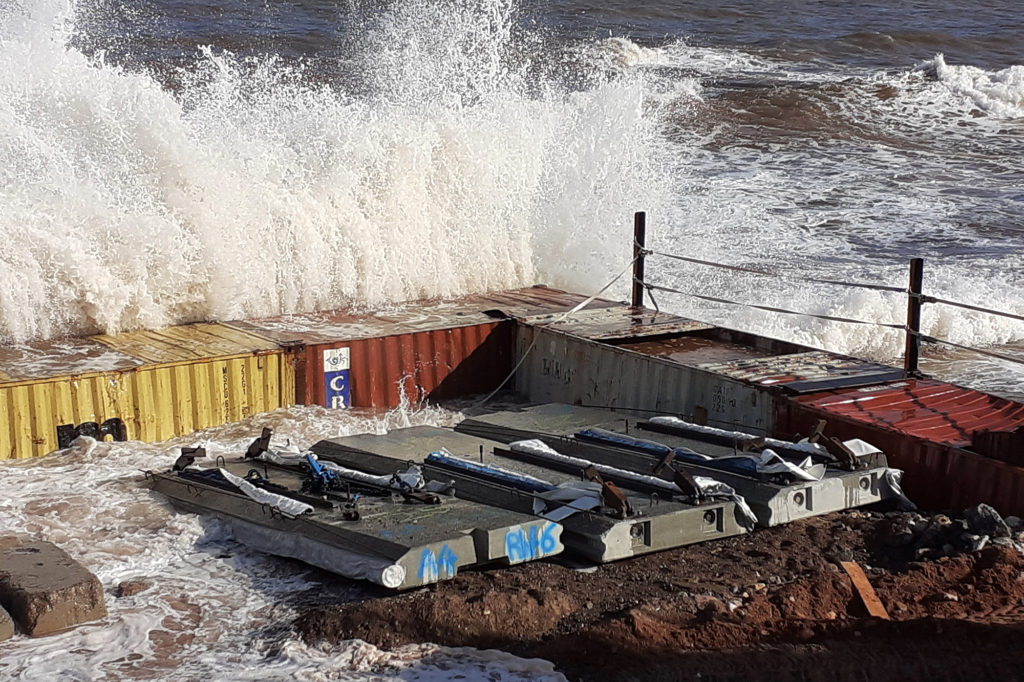
Jack Brookes, agent for BAM Nuttall, told Rail Engineer that, on good tides, three wall units can be installed in the time available. The next step is to provide grout to three areas of the wall units. On each tidal working, 3½ tonnes of a special grout are mixed and placed by hand. The bases of the wall units, where they sit in the preformed trough, are grouted in and the vertical space between adjacent wall units is grouted using a woven geotextile ‘sock’ which expands to close the gap when filled with the rapid-hardening grout. Also, because there is only a tangential contact between the back surface of the wall units and the CHS piles, grout socks are also placed and filled in these positions in order to give a greater bearing area.
The grout is a special rapid-setting non-shrink specification which achieves compressive strengths in excess of 12MPa after one hour. The early strength gain requirements are needed to support assumptions made with the temporary supporting of the facing panels prior to them being backfilled.
The final stage of the basic wall construction is the infilling between the old masonry wall and the rear of the new wall with mass concrete in maximum lifts of 1.0 metre. This can be done without the need for track possessions. Under-track crossings have been put in, enabling concrete to be pumped from delivery at the Up-side station yard, and, with a range of 160 metres from the pump being achievable, only two under-track crossings are needed, positioned at the third points along the site.
In total, it is estimated that around 7,000m3 of concrete will be used. In view of this large quantity, BAM Nuttall has worked with Hanson to develop a low-carbon concrete to minimise the environmental impact.

A serious problem with the existing wall has been the fairly frequent overtopping by waves, leading to significant flooding of the railway tracks and line closures. The new design of wall has taken this problem into account as a part of the optioneering of various designs and it is expected that the frequency and severity of overtopping will be reduced by 90%. However, the provision of drainage from the track is still required so piped outfalls are incorporated into the mass concrete infill at 20-metre intervals. Special facing wall units with a cast-in outlet for the outfall are installed at these positions.
Plant access and materials storage
Access to the working area on the beach is severely restricted by the low-headroom railway bridge across Dawlish Water and the pedestrian access to the sea front, so only small plant is brought to the worksite this way. Large plant, excavators and a mobile crane are loaded onto a multi-purpose landing craft – the MTS Terramare with its 50-tonne load capacity – at Teignmouth docks and delivered to the beach at Dawlish. To protect the plant when not in use at high tide, refuges have been put in at each end of the site. These refuges take the form of a U-shaped layout of steel freight containers fully loaded with beach material, thereby forming effective protection for the plant.
Most materials, apart from the pumped concrete already described, can be brought in under the railway bridge. Even the large precast wall units, which are stored until needed in an off-road compound not far away, can come in this way on trailers and unloaded into the refuge at the south end of the site ready for installation. The CHS piles were also brought to site by this route.
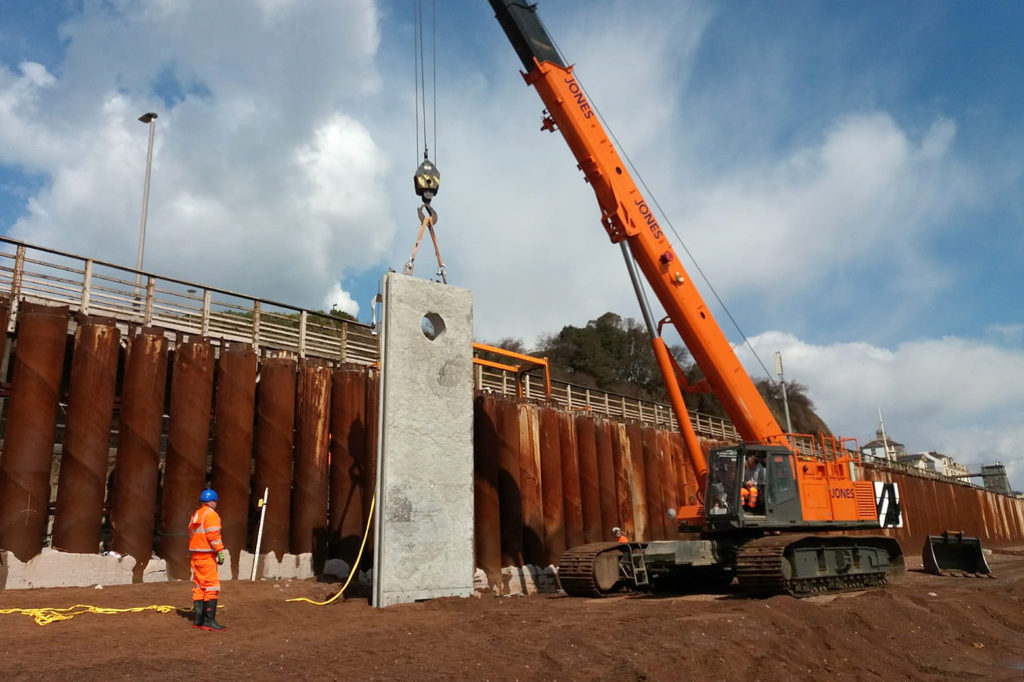
Working arrangements
BAM Nuttall has around 30 employees here, based at their main site offices at Dawlish Warren. The labour force is comprised of 60-70 staff covering two shifts equally, split between BAM Nuttall and TBT Recruitment Ltd. BAM Nuttall has taken several measures to alleviate some of the features of tidal working disruptive to the body clock. Working every tide, i.e. twice per 24-hour period, is slightly offset by giving staff alternate weekends off duty. Also, by moving the start and finish shift times each day to accurately follow the tide times, i.e. advancing by around one hour per day, would maximise the available site time. However, Jack Brookes explained that they have preferred to maintain the same shift times for 4 days consecutively so as to not confuse the circadian rhythm more than necessary.
Furthermore, the Health and Safety Executive’s Fatigue Risk Index is calculated on a regular basis to monitor for hazards related to disruptive shift working. The objective is to ensure that scores are kept below 40 which is the maximum recommended on the range from 0-100 on the Index criteria.
JP Crane Hire and Lynch are the main plant suppliers whilst Camfaud is the subcontractor for the concrete pumping. SGC provides safety-critical resources. Also, Network Rail was keen to emphasise the use of local suppliers – particularly of materials – to the tune of somewhere between £5-10 million out of the overall project value of £80 million.
Stage 1 was valued at £25 million, Stage 2a, which will be complete by Autumn 2021, is another £30 million and Stage 2b, which is out to tender at present, will be carried out between Autumn 2021 and Winter 2022.
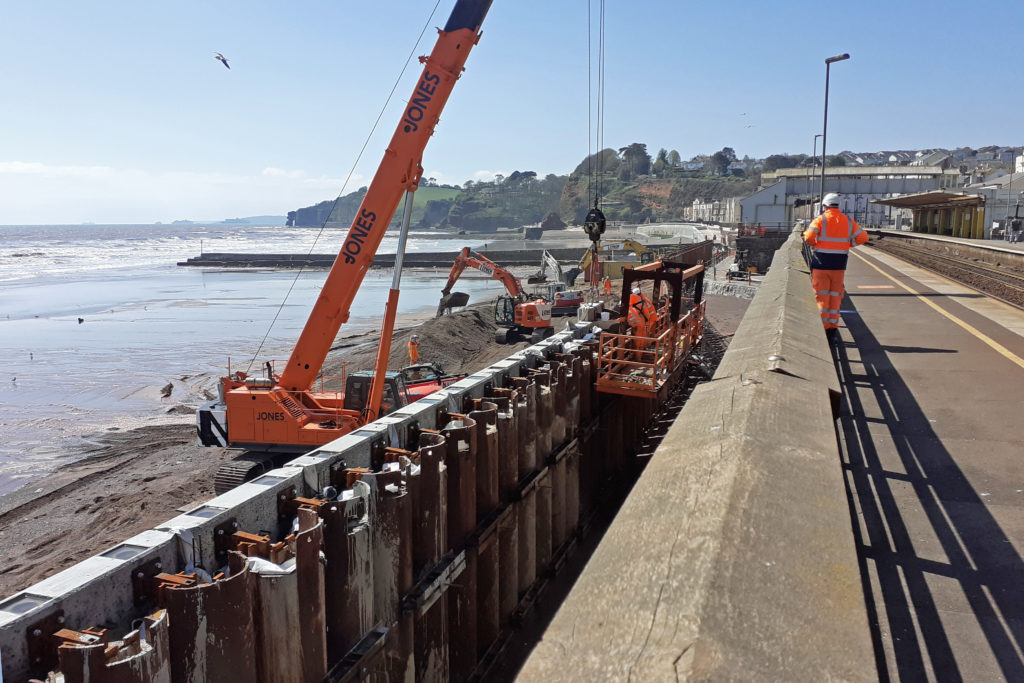
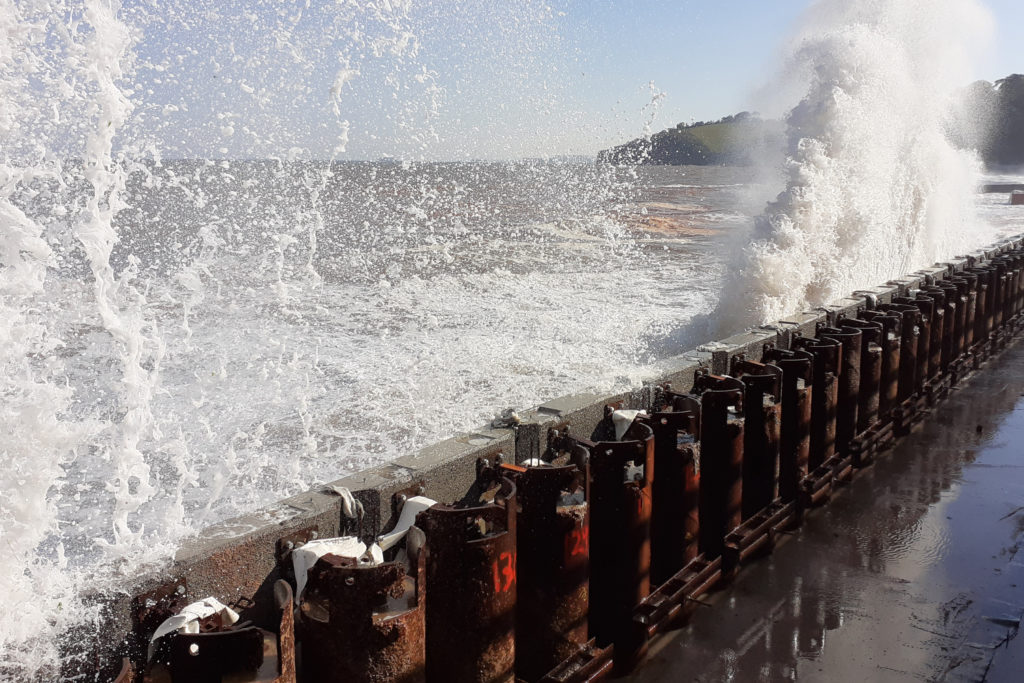
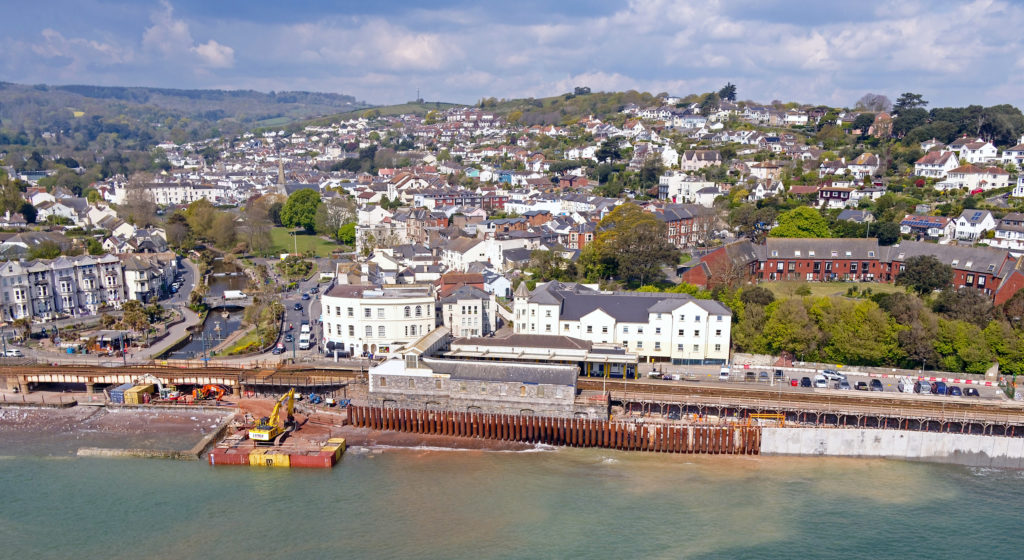
They say that walls have ears, but this one only has instalments. Rail Engineer will return to Dawlish next year to review the successful completion of Stage 2a and report on progress with the most complex piece of the jigsaw, Stage 2b. This will link up with the two earlier stages and greatly enhance the station. Once complete, the project will give this vital railway artery better defence against the sea than ever before in its long history.


The Sea Wall should have been constructed 500m to 1000m metres out in the sea parallel to the railway line. This infill would have been a highly effective buffer to prevent ANY future storm (sea water) damage and would have created a great recreational zone. It would have been a tourist magnet, attracting tourists who could visit the seaside and have ample room for laylos, beach chairs, or just a towel on the sand and or shingle in-fill. Think of the reclaimed land as a Brighton or South-end Pier that is parallel and adjacent to the former coastline.
Wasted opportunity due to Lack of foresight and Lack of vision.